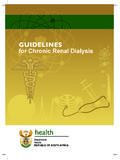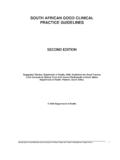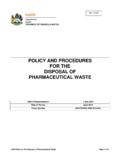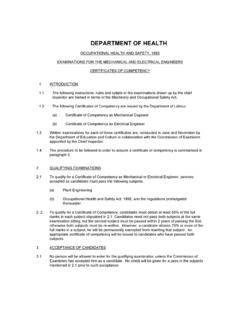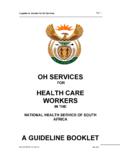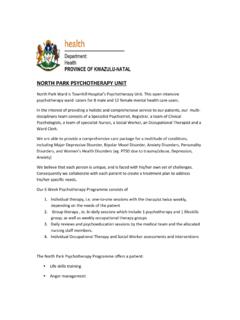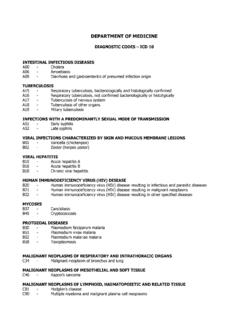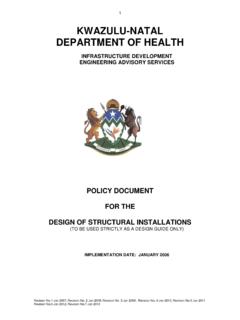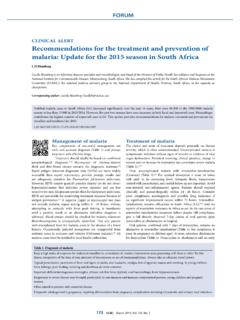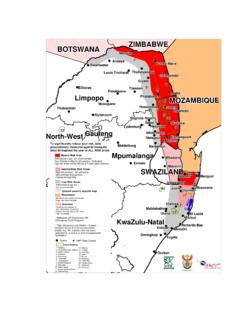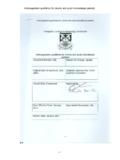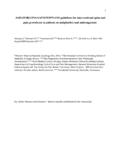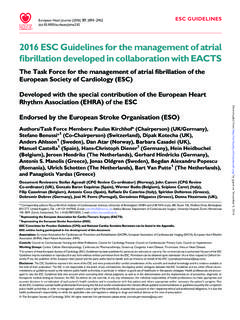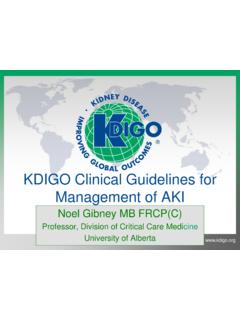Transcription of Guidelines for the optimal care of patients on …
1 Guidelines for the optimal care of patients on chronic dialysis in south africa This document was drawn up by a subcommittee of the south African Renal Society. Members: M R Moosa (Chair) S Naicker I Naiker M Pascoe B van Rensberg SARS chronic dialysis Guidelines 2 Guidelines for the optimal care of patients on chronic dialysis in south africa Introduction The number of patients with endstage kidney failure receiving dialysis treatment in south africa has increased rapidly over the past decade as a result, mainly, of the expansion of dialysis facilities in the private sector as well as an increased awareness and diagnosis of chronic kidney disease.
2 This has placed an enormous burden on health systems in general and on funders in particular. The cost of dialysis treatment is prohibitive. In order to ensure the provision of a good standard of treatment and optimum utilization of scarce resources the institution of Guidelines to ensure quality of treatment is essential. These Guidelines serve to ensure that overall best practices are maintained; that some uniformity and equity in treatment is maintained throughout the country and that some patients are not disproportionately advantaged over others purely on the basis of limited resources; that a level of self-audit be ensured; satisfy funders that resources are optimally and responsibly utilized.
3 Last, but by no means least, implementation of these Guidelines should result in overall improvement in the standard of patient care . These Guidelines are for implementation in all dialysis units, both in the State and private sector. In order to revise these Guidelines input was obtained from nephrologists, and renal technologists and nurses affiliated to the south African Renal Society and the Renal care Society of south africa , respectively. This is the second draft after the first was circulated to all participants for comment. Extensive use was made of the European Best Practice Guidelines (EBPG) and the Kidney Disease Outcomes Quality Initiative (K/DOQI) Guidelines in drawing up the current document.
4 Recommendations pertaining to infection were based on American Centers for Disease Control and Prevention (CDC). Elsewhere, SARS chronic dialysis Guidelines 3evidence-based recommendations were used wherever possible. It needs to be accepted that best practices will change as new evidence becomes available and it is recommended that these Guidelines be reviewed at least every 2 years. An undertaking of this nature requires the effort of several individuals and I am most grateful to all those who made that effort to ensure the success of this important project. I am particularly grateful to the Renal care Society of south africa for its very worthy contribution and the high quality of its submission.
5 The final document will be submitted to the National Department of Health as an important guide to ensure that patients around the country receive dialysis treatment of the highest quality at all times. Signed, M R Moosa March 22, 2006 Cape Town. NB.: This document was unanimously adopted at the Annual General Meeting of the south African Renal Society held on March 20, 2006 at the Cape Sun, Cape Town. These Guidelines pertain to adults only; those for children are being drafted. SARS chronic dialysis Guidelines 4 Clinical Guidelines 1. Measurement of renal function The preferred method of estimating the glomerular filtration rate (GFR) in advanced renal failure is the abbreviated Modification of Diet in Renal Disease (MDRD) study equation.
6 Note 1: Because of the unreliability of urine-based GFR estimations, these should no longer be used. Note 2: The Cockroft-Gault equation over-estimates the GFR and should be limited to use in patients with mild renal failure (GFR > 50 ml/min). Note 3: The MDRD study equation overestimates the GFR in blacks by 18%. Until further information is available, patients of other race groups default to white, although the formula has not been validated in racial or ethnic subgroups other than Caucasians and African Americans, Note 4: The MDRD study equation has not been validated in children (age <18 years), pregnant women, the elderly (age >70 years), in individuals with normal kidney function who are at increased risk for chronic kidney disease (CKD) or in normal individuals.
7 2. Who should be tested Individuals at increased risk for chronic kidney disease should be tested at the time of a health evaluation to determine if they have chronic kidney disease. These include individuals with the following: Diabetes Human immunodeficiency virus infection Hypertension Heart failure Atherosclerotic coronary, cerebral, or peripheral vascular disease SARS chronic dialysis Guidelines 5 Autoimmune diseases Systemic infections Exposure to drugs or procedures associated with acute decline in kidney function Recovery from acute kidney failure Age >60 years Family history of kidney disease Reduced kidney mass (includes kidney donors and transplant recipients).
8 Note 1: Tests should include the GFR using Cockroft-Gault or MDRD equations (see above); assessment of proteinuria, and examination of urinary sediment or dipstick for red blood cells and white blood cells. Note 2: Estimated GFR should be monitored yearly in patients with chronic kidney disease, and more frequently in patients with: GFR <60 ml/ m2 Rapid GFR decline in the past ( 4 ml/ m2) Risk factors for rapid progression Ongoing treatment to slow progression Exposure to risk factors for acute GFR decline. 3. When to refer to a nephrologist a) GFR < 60 ml/min (recommended); GFR < 30 ml/min (mandatory) b) Serum creatinine > 150 mol/l (more than 2 consecutive readings) c) Persistent proteinuria and/or haematuria Note 1: At GFR <60 ml/min interventions to retard or prevent the progression of chronic renal failure should be instituted SARS chronic dialysis Guidelines 6 Note 2: At GFR < 30 ml/min, options for renal replacement need to be considered.
9 Consider preparing vascular access and working up for transplantation. Note 3: At GFR < 15 ml/min, be vigilant for complications such as hypertension, fluid overload, electrolyte disturbances and malnutrition. 4. When to initiate dialysis dialysis must be started when the GFR is ~6ml/min or when the GFR is less than 15 ml/min and the patient has one or more of the following: a) Symptoms or signs of uraemia b) Diuretic resistant fluid overload c) Poorly controlled blood pressure d) Evidence of malnutrition Note 1: Diabetics should be initiated on treatment earlier. Note 2: K/DOQI Guidelines recommend starting dialysis at GFR of ~10 ml/min or earlier if there are signs of malnutrition Note 3: Costs and the inconvenience to patients should be weighed up against the theoretical benefit of improved prognosis 5.
10 Adequacy of dialysis a) Dose The dialysis team should routinely measure and monitor the delivered dose of haemodialysis (HD). The dialysis care team should deliver a prescribed HD dose per session: Thrice-weekly schedule, a midweek Kt/V of at least minimum and optimal , and URR of 65% Twice weekly schedule, a Kt/V of and URR of 80%. Note 1: Patient survival has been shown to increase in association with increases in Kt/V up to Note 2: Twice-weekly schedules are not recommended. SARS chronic dialysis Guidelines 7 Note 3: Clinical signs and symptoms alone are not reliable indicators of haemodialysis adequacy. Technique The delivered dose of haemodialysis should be measured using formal urea kinetic modeling (UKM), employing the single-pool, variable volume model (Kt/V), or at institutions where this is not possible, the urea reduction ratio (URR).
